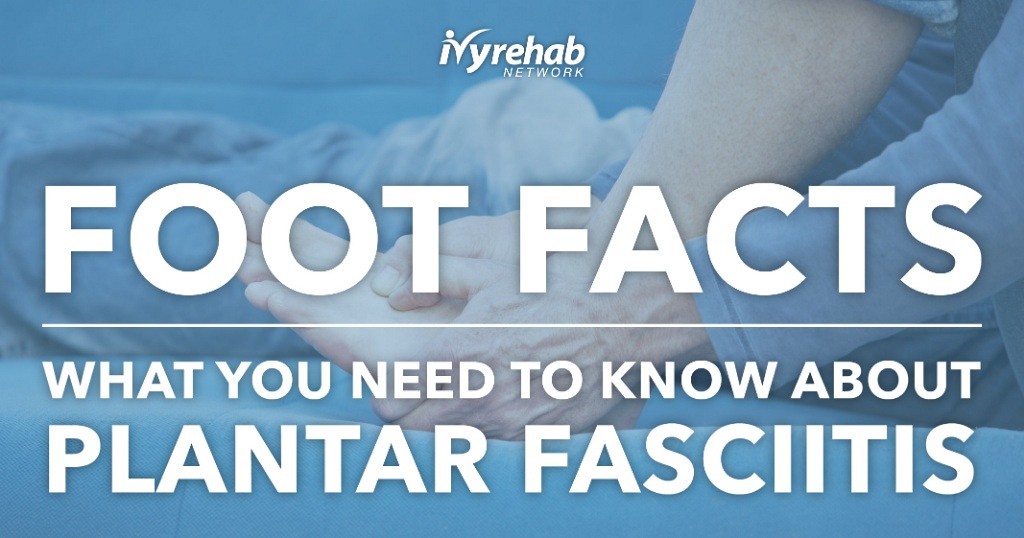If you are experiencing heel pain, especially after walking all day or running long distances, you may have plantar fasciitis. It’s a common condition characterized by pain and inflammation of a thick band of tissue, called the plantar fascia, which is similar to a bowstring. The plantar fascia runs across the bottom of your foot and connects your heel bone to your toes. Many times plantar fasciitis develops due to chronic poor posturing of the foot during weight-bearing activities, such as walking all day at your job. It’s also common in runners and people who are overweight.
Most people experience a sharp, stabbing pain in the heel. This often occurs when you first get out of bed and take a few steps in the morning, or when getting up after prolonged periods of sitting. When sleeping or sitting, the plantar fascia becomes tight. Once you are up and walking, the plantar fascia loosens and the pain normally decreases. Other notable symptoms include pain in the arch of the foot, pain that increases over a period of months, and swelling on the bottom of the heel.
What Causes Plantar Fasciitis?
Causes of plantar fasciitis vary but there are risk factors that can increase your chances of developing the condition:
- Improper foot mechanics, being flat-footed, having a high arch, or even having an abnormal pattern of walking
- Occupations that require walking or standing on hard surfaces, including teachers, factory workers, carpenters, and nurses
- Faulty footwear can affect the way weight is distributed when you’re standing and put added stress on the plantar fascia
- Overuse or increase or change inactivity
- Weight fluctuation and obesity
- Age as plantar fasciitis is most common in women and men between the ages of 40 and 60, and typically affects one foot
- Certain types of exercise including long-distance running, jumping, ballet, and high-intensity training
If tension on the plantar fascia becomes too great, it can create small tears in the fascia. Repetitive stretching and tearing can cause the fascia to become irritated or inflamed. Ignoring the symptoms of plantar fasciitis may result in chronic heel pain. If left untreated, it can lead to foot, knee, hip, or back problems from overcompensating.
Treatment Options for Plantar Fasciitis
Plantar fasciitis usually goes away in several months, but it is best to visit your doctor for an official diagnosis and rule out other injuries. There are a variety of lifestyle changes and treatment options that can help, along with education and physical therapy.
- Stretching exercises. Stretching out the calf muscles can help ease pain and assist with recovery.
- Limit activities. Give your heel a rest by reducing physical activities.
- Buy good shoes. Invest in supportive shoes that have good arch support and a slightly raised heel.
- Ice. Using an ice pack on your heel for 20 minutes a day can reduce inflammation. Do not apply ice directly to the skin.
- Avoid going barefoot. When you walk without shoes, you put undue strain and stress on your plantar fascia.
- Medications. Oral nonsteroidal anti-inflammatory drugs (NSAIDs), such as ibuprofen, can help reduce pain and inflammation.
Minimally invasive procedures include extracorporeal shock wave therapy (ESWT) and radiocoblation (Topaz). Few people need surgery to detach the plantar fascia from the heel bone. It’s generally an option only when the pain is severe and all else fails. Side effects include a weakening of the arch in your foot.
Physical Therapy Can Help Plantar Fasciitis
If at-home treatments don’t relieve your symptoms, physical therapy is a good option for foot pain and plantar fasciitis. A good way to think of rehabilitation is in two phases: first, control the symptoms and aggravating factors; second, prevent future flare-ups or reoccurrences.
Phase one of physical therapy may include treatments such as hot/cold packs, electrical stimulation, or ultrasound. Gentle non-weight bearing stretching and range of motion (ROM) activities are often recommended. Manual therapy techniques include joint mobilizations and soft tissue mobilizations. The Graston Technique, a form of instrument-assisted soft tissue mobilization, is a specific type of manual therapy provided by certified physical therapists and is an effective complement to stretching and strengthening. PTs also focus on education, such as wearing proper footwear and using ice packs at home, to prevent and change daily habits that may be triggering symptoms. The goal is to help control and eliminate symptoms such as pain and inflammation.
Phase two is designed to prevent reoccurrence by eliminating the source of the fasciitis. Re-establishing correct foot mechanics, the way in which the foot impacts the floor throughout gait, is critical in preventing future symptoms. Routinely orthotics or proper-fitting shoes are recommended to support unstable or high arches. Additionally, strengthening and balance training activities are beneficial to ensure proper force transfer through the foot during stance and minimizing stress through the plantar fascia. Ivy Rehab also offers a special Running Analysis Program.
Don’t go another day with a throbbing heel or chronic foot pain, especially if you have been diagnosed with plantar fasciitis! Contact your nearest Ivy Rehab Network clinic for an assessment or to talk to a physical therapist about your symptoms and how they can help.
Article Reviewed by Holly Lookabaugh-Deur, PT, DSc, GCS, CEEAA
Holly Lookabaugh-Deur, PT, DSc, GCS, CEEAA is a practicing physical therapist and a partner and Director of Clinical Services at Ivy Rehab Network. Deur is board certified as a geriatric clinical specialist and certified exercise expert for aging adults with more than 35 years of clinical experience. She is certified as an aquatic and oncology rehabilitation specialist and serves as adjunct faculty at Central Michigan University and Grand Valley State University.






